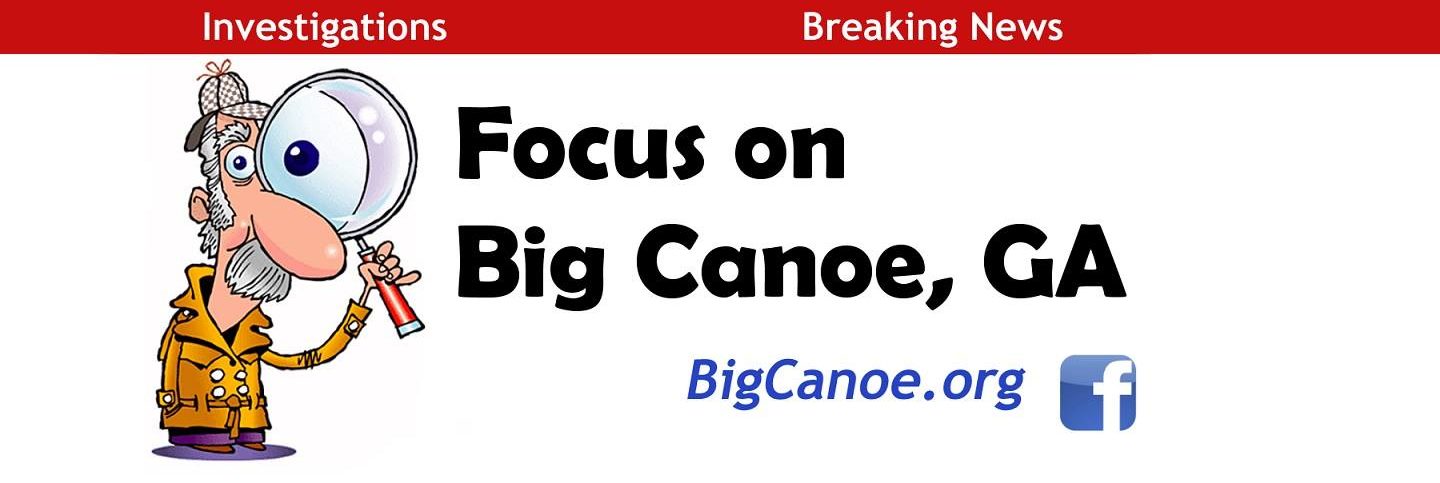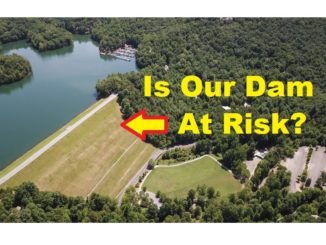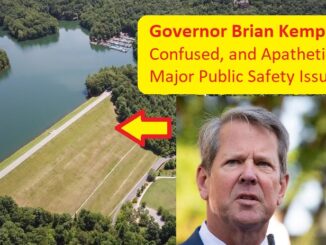
The recent article, L.P.D. Review of Records Reveals BIG PROBLEMS, was the 2nd article in a Series on Georgia’s 2nd largest earthen dam. The Big Canoe POA responded, and continues to respond, to the issues raised by issuing verifiably false information. They have also gone to great lengths to conceal documents regarding the safety issues of the Dam.
This 3rd Article in the Series is long, and will be broken into the following segments:
I. Summary of Historical Safety Reports
II. Coverup, Lies & Deception / Situation Report
III. The previously never shared 112 Pg 2020 Emergency Action Plan (10Mb PDF)
IV. Failure to Maintain Insurance Requirements?
V. Likelihood and Potential Consequences of a Catastrophic Failure
VI Moving Forward
I. Summary of Historical Safety Reports
The Dam is not safe against a Seismic Event, and this fact has been reported and warned about for decades. (1) (2) (3) In the late 90’s Big Canoe was actually threatened with enforcement action if the condition was not remedied. (4) At that time they contracted Geosyntec to propose plans to fix the situation. Plans to fix the situation have not been implemented, and that fact was acknowledged by the head of the Georgia Safe Dams Program, again, in 2009. (5)
Georgia Safe Dams has failed to perform adequate oversight, and has negligently looked the other way. Big Canoe POA has failed to perform mandatory maintenance, repair and inspections. Due to this combined effort by the POA to willfully and negligently ignore this costly situation, exacerbated by an enabling engineer, and allowed by an irresponsible bureaucrat (Tom Wolsey of Georgia Safe Dams), we have reached a point of either financial crisis, or calamitous physical disaster, as the Big Canoe Lake Petit Dam reaches it’s end of life cycle, and the risks of catastrophic failure increase.
The Emergency Lower Lake Drain that sits at the bottom of Lake Petit has “never” been opened in the entire 49+/- year life of the Dam. It is the first line of defense against a failure of the Dam. Opening the valve is not an option as the odds are high that the entire guts of the Dam could be blasted out, causing a rapid and complete catastrophic failure. Another risk is that the valve could get stuck in the open position, which would cause a rapid emptying of the lake, which could lead to slope sides along the edges, leading to the potential for property damage to homes around the lake. This one issue alone is a legal violation of Big Canoe’s PERMIT to Operate a Dam.
Getting the Dam up to “Seismic Code” most likely involves prohibitive amounts of money, and potentially permanent intrusions to the “feel” of the area. The 1st, and most engineeringly traditional solution involves substantial increase to the size of the Dam, expanding the “Toe” (base) well into the Ballfield below. The 2nd solution (even more improbable) involves digging and installing a deep drainage trench (aka a Chimney Drain) along the entire width of the lakeside face, basically building a subterranean drainage wall deep within the entire Dam – without destroying the dam. Both solutions involve slowly draining the lake for an extended period of time. Both are most likely prohibitively expensive when considering such action in regards to a dam the size of the one at Lake Petit.
Fixing the lower lake drain is a completely separate issue, and most likely would involve digging up the ENTIRE center core of the Dam, and replacing / repairing the drain and internal gates. Having a lower lake drain is a legal permit requirement for an earthen dam of this size. It is inconceivable that any financially reasonable work around exists. Spillways do not do deep drawdowns and are not a solution to the minimum requirements. The only alternative is most likely to install new deep water intake lines, and channel them upward into a Newly Built Mega Pump house. When I say “Mega” it is exactly what is implied. It would need to be a pump capable of drawing extreme volumes of water in a short time, capable of greatly lowering Lake Petit in a very short timeframe. This alternative seems a “Pipe Dream”, as the costs for such a construction and mechanical venture would be astronomical.
Petit Dam is 49 years old, and the design lifespan for an earthen dam is 50 years. Petit Dam has a Clay core, which is the “most” susceptible to slide failure when saturated, and the March 2020 Geosyntec Report showed the inner water table to have risen to all-time-highs (a very bad thing). Further, the original dam design is most likely below current Permit Standards, and if it ever fails, or is required to be breached for repair, the Requirements for a new Permit would cost prohibitive. Eventually the Lake will most likely have to either be permanently shrunk, or drained to something like a “Nature Marsh”. Million$ of Dollar$ may delay it, but eventually it happens.
II. Coverup, Lies & Deception
There is a big difference between downplaying something, stretching the truth…. and simply flat out LYING.
Has Big Canoe Management & the POA Board stepped over that the line, and entered into the territory of intentionally lying to the Community (and Region) in a coordinated and intentional effort to Coverup all of the mistakes, errors, bad decisions, and irresponsible acts that have occurred in regards to their legal responsibilities in properly maintaining the Lake Petit Dam, and in regards to their fiduciary responsibilities to the Property Owners?
As a 21 year resident of the community that has long followed this issue, has dug dug up records, and has read almost every statement ever publicly made by the POA on the issue…. I have already formed a very strong opinion on an answer to the above question. However I realize that most residents still won’t know half of what I do after reading this article. The issue spans so much time, and is so complex, that it is hard to timely present in mere articles.
For this reason I will soon be launching a website dedicated exclusively to hosting public access documents to all the historical documents related to the issue. I will be uploading enormous volumes of public record documents, Board Meeting Notes, Newspaper Articles etc, so that interested parties can comprehensively access the information. I have just purchased the domain, www.LakePetitDam.com, for the exclusive purpose of sharing information in a public fasion. Officials, Engineers, Lawyers, Property Owners (in and out of Big Canoe); and POA Management will all be able to access documents. This is necessary since the Big Canoe POA is intentionally withholding critical information from Property Owners & Regional Residents, such as the recent 25 Pg Geosyntec report, and the even more recent 833 Pg Comprehensive Report. No one I have talked to has any faith that the “virtual community coffee” being scheduled will be anything more than a carefully controlled, glossy spin of facts.
I am beginning with the release of the Lake Petit Dam “Emergency Action Plan”, a very important public document that has long been hidden from public view.
III. The previously never shared 112 Pg 2020 Emergency Action Plan (EAP) (10Mb PDF)
Here are some key takeaways from the above document.
- Big Canoe Residents are entitled access to this “public record document”, but Big Canoe Management and Board of Directors have refused transparency on the matter. (See formal POA Records Request and the POA Response, and also Ask The POA Request & Response – See Pg 2) This newspaper eventually obtained it, via a simple Open Records Request to the Safe Dams Program. In case anyone is concerned with the language at the bottom of each EAP page “For Official Use only – Not for Distribution” that is something added by Big Canoe. It is NOT included in the Official Georgia Safe Dams EAP Templates (see files here).
- Part of the reason for having an EAP is so that those in the path of harm can be NOTIFIED in the event of a potential Dam breach. Big Canoe has only updated the EAP Contact Lists in 2007, 2017, 2018. Page 6 of the EAP clearly lists “Residents downstream of the Dam” as being on the Notification Flowchart, but the current EAP has emergency contact information that is 3 years old. For example, the home most dangerously located in the flood path (bottom of Twin Creek Dr) has an owner contact who sold the property 2 years ago, leaving the current owner unlisted. They were even told to keep up with the reviews in a 2017 Letter from Ga Safe Dams. Out of date owner data is still not updated in the 2020 EAP. Big Canoe POA and Management isn’t following guidelines, and obviously doesn’t care enough about the safety of residents to keep the EAP updated on an annual basis.
- Here is a 1 page PDF Excerpt that describes the general timeframes of what gets destroyed, and how fast, in the event of a Dam failure. It only hits the highlights, and actually leaves out some critical items, but it is an eye opener. I go into greater detail in Section V. below.
- Big Canoe is NOT keeping up with the documentation of required “Record of Annual Review” & “Record of Periodic Testing” (Pgs 108, 109 in 2020 EAP). This is consistent with previously filed annual submissions, such as the 2019 EAP. Open Records Requests, and conversations/emails with Georgia Safe Dams authorities have also confirmed that Big Canoe has NOT been timely doing / filing the required inspections & maintenance reports over the years.
- IMPORTANT: In every single category of Level II Preplanned Operation Response listed in Table 5 of the EAP, the very 1st course of action is listed as “open the sluice gate on the low level drain” to “lower level of the lake”. The sluice gate on the low level drain is that thing required by our Permit to be operational; which has NEVER been operational in the entire 49 years of the Dam’s existence; that we have wasted countless monies over 20 years trying to figure out how to deal with the issue, sending down dive teams twice in the past 15+/- years; and that we are afraid that if we open it we will not be able to close it, and it will drain the entire Lake and potentially cause landslides on properties around the lake shore – or that it will blow the guts out of the Dam and cause an immediate catastrophic failure. That “Sluice Gate on the Low Level Drain”!!! Which we can NOT open, and that by not having it operational is a serious legal & safety breach of our Operational Permit requirements!
IV. Failure to Maintain Insurance Requirements?
Big Canoe has spent plenty of money on Insurance for the Dam over the years. As usual, Big Canoe Management and POA is totally non-transparent on our insurance polices, but we do have some records of reference to guide us.
In the “2018 Long Range Planning Document, Pg 61” states:
ii. Lake Petit Dam. The dam on Lake Petit is over 40 years old, and has known issues that are monitored on a continued basis by POA and state officials. The POA carries $25M in liability insurance on failure of the dam, and property insurance on the dam of $2M. The health of the dam continues to need monitoring and any corrective action taken as necessary. An emergency evacuation plan should be published and every structure in the path of a catastrophic failure of the dam should be trained in evacuation procedures.
In response to a Property Owner “Ask the POA Ticket # 790” Scott Auer stated:
“Thank you for your inquiry regarding the Big Canoe Property Owners Association, Inc. (“Association”) pertaining to the Lake Petit Dam. The Association is fully and properly insured with regard to this
Common Area Property.”
Suddenly, in the January 2021 POA Board Meeting it was stated:
“the renewal of our property insurance that was done on december 29th using Marsh & McLennan we basically renewed our insurance with a couple of changes ….. and this excluded the dam“
The POA has refused to share information regarding the Insurance Policy. All we know is that suddenly, after reporting on the Dam Safety Issues recently began, and after the questions in “Ask the POA Ticket # 790“, suddenly it appears that the Insurance on the Dam was not renewed.
Why was the Insurance Cancelled?
- Did the POA cancel all or part of our Insurance Policy? Why?
- Did the Insurance Company refuse to renew? Why?
- Did questions about the POA’s failure to properly maintain Dam Safety Permit requirements create an uninsurable situation?
- Did the Insurance company raise the Premiums due to increased risk?
- Is there any actual Insurance that would protect the community in the event of a catastrophic failure? Are there any Exclusion Loopholes (i.e. would negligence it would void the policy)?
- Is the Lake Petit Earthen Dam listed anywhere in our existing policies as an excluded risk?
- Is their any Specific Policy Rider that addresses issues of the Lake Petit Earthen Dam?
- In the past there have been indications that the “$25M in liability insurance on failure of the dam” is simply more of play on words that the POA so often does. For example, this paper has been provided with a copy of the Marsh & McLennan 2018 Annual Insurance Review. Surely the POA isn’t claiming that the Property Coverage or General Liability would cover the damage from a catastrophic dam failure? If so, has then been verified in writing between Marsh McLennan and the POA?
- Lastly, aside from the catastrophic damage to infrastructure, golf courses, amenities, buildings, the sconti dam, roads, bridges and water treatment plants – is there any coverage for the actual Lake Petit Dam itself? the Spillway?
These are all valid questions considering the magnitude of consequences if the Dam were to fail.
V. Likelihood and Potential Consequences of a Catastrophic Failure
As more documentation of historical negligence has come to light, and as the seismic safety of the dam continues to be in question, my confidence that we might not experience a catastrophic failure has decreased. I have talked to many b.c. property owners that are concerned. At this point I believe that nothing short of complete transparency, and opening up of ALL reports and studies will assuage that community concern.
And there should be concern. The data in the 112 Pg Emergency Action Plan contains Innundation Maps, Maximum Wave Heights, and specific data on the path of destruction that would ensue from a catastrophic failure. But they are cold numbers, that lack the force of explanation. Let me try and paint a picture of the aftermath of a dam failure using the data from the EAP. Using the modeling presented in Appendix B (Pgs 31 – 88) the following is what would happen in the modeled Dam Failure.
The Ballfield, Playground, and Water Station just below Lake Petit could experience a breach wave of 1.68 Million Gallons of Water Per Second. Everything would be gone, including the road. The Chapel, Real Estate Offices and Chimneys area would face a Maximum Wave Height (“MWH”) of 50+ feet. Creek 2, 3 & 9 would be severely damaged. At 9 minutes the wave would cross Lake Sconti. Shortly thereafter Lake Sconti Dam would fail and unleash a combined Sconti/Petit Flood across Choctaw 9 at a MWH of 70+ feet. Choctaw 1 – 4, Twin Creek Dr, and the Twin Creek Water Pump station would face a Maximum Wave Height of 60+/- feet rushing allong carrying tree and other debris (possibly cars) crushing everything in its path. This wave would crash over the Covered Bridge, then move downstream at a decreased MWH of only 50 +/- feet. The raging floodwaters would destroy the Main Water Plant, and wipe away Cove Rd leaving only a deep gorge. The flood would then sweep into Cove Lake (aka Cox Lake) where the modeling shows Dam Failure in 30 minutes. If Cove Lake goes, the combined Maximum Wave Height below the dam is estimated at over 90 feet. That will sweep through the residential and rural lands of Marble Hill, destroying everything in it’s path. Just over an hour after the intial Lake Petit Dam breach, a Maximum Height 32 foot wall of water will hit the culvert under Hwy 53, near the marble quarry. Modeling shows that it will take a mere 10 minutes to failure, thus cutting off all of Marble Hill and Big Canoe from the western portions of Pickens County.
The destruction to property, homes and infrastructure will be devastating. Loss of life will most likely be inevitable. Along the path of the flood will be a broad swatch of scarred landscape. A large portion of the area will be left without water (destroyed water infrastructure from Big Canoe). The main entrance to Big Canoe will be cut off. Sconti Lake and Lake Petit dams will be drained, their dams shattered, probably never to be rebuilt in the case of Petit. Choctaw Neighborhood will be cut off from Big Canoe except for the Steve Tate entrance. Road across Lake Petit Dam is gone. Entire community traffic will be funneled up and out of the Bluffs Exit, or through mountainous back residential neighborhoods to get to the North Gate.
I don’t need to tell you what Property Values will look like. Big Canoe will be swallowed by lawsuits. Outside of Big Canoe the entire community of Eastern Pickens County will be cut off from traditional Schools, Shopping, Employment. It will be years of rebuilding and inconvenience.
It gets worse….. this is based on a Model from 1998 that used data suggesting that Lake Petit only holds 6,000 acre feet and is only 115′ tall. In reality the Dam holds 7000+ acre feet of water and is approximately 125 feet tall. To quote a 2017 Letter from Georgia Safe Dams as they they told Big Canoe to rework the Innundation data, “The difference in height and volume will have an appreciable effect on the downstream inundation.” So it is possible that the above isn’t even the worst case scenario. For the record, Big Canoe was told to get this done almost 3 years ago. Still hasn’t happened. More of the same. Golf and Clubhouse Remodels are a bigger priority.
I hope this helps people get the picture of what the potential consequences of ignoring the existing and substantial Dam Safety Issues are.
VI. Moving Forward
Big Canoe is not a poor and broke community that can’t afford to fix this problem. Management and the POA Board routinely tout multi-million dollar projects, such as the recent $3.5 Million dollar Creek Golf Course remodel. The 8% of Golfers in the Community need to have the lay of the greens and tees mixed up a bit, as they have gotten tired of playing the same 27 Holes day in and day out. How Boring! And let us not forget the nearly $6 – 7 Million that is in the plan to renovate the Choctaw and Cherokee courses. Or the Hundred$ of Thousand$ of improvements needed on the already $11 Million Dollar Clubhouse! Of course we need to spend Million$ & Million$ more moving the Postal Center, and revamping the Chimney’s Meeting Rooms and Restaurant facilities. Let’s not forget the hefty Marina Updates – Lakeline Remodeling and New Fleet of boats included! And ironically… ALL of that may be wasted money if we don’t take care of the basic maintenance and safety issues that have long been ignored with Lake Petit Dam, and that underpin it all. Priorities seem out of order.
And make no mistake… if Big Canoe continues to ignore it’s obligations, and violate it’s legal Dam Operations Permit requirements…. then people outside of Big Canoe, in the surrounding regional area may pay the ultimate price for that negligence as well! Because disasters that start in Big Canoe, don’t stay in Big Canoe.
I believe that people should be contacting Georgia Safe Dams, and they should also be contacting the Governor’s Office (buck stops with Gov. Kemp on oversite of Georgia Safe Dam issues). Even better, cut and paste a copy of the URL to this article, and email it to every politician, news media outlet, EPD Official, AND the Governor’s Office.
- Safe Dams Program, 2 Martin Luther King Jr. Drive, SE, Suite 1362, Atlanta, GA 30334 (Phone: 404-463-2461)
- Office of the Governor, Brian Kemp; 206 Washington Street, Suite 203, State Capitol, Atlanta, GA 30334 (Phone: 404-656-1776)
- Some people have discussed the idea of a Regional Petition to send to the Governor, demanding he force the Director of the Safe Dams Program to take enforcement action. If the situation doesn’t get more transparent quickly – I think that may be the next move for the community to make.
Last option of course is to get lawyers involved. It may come to that in the end. Big Canoe POA & Management continue to give no indication that they are taking this seriously, nor are they willing to share the results of recent inspections and studies. Their current plan of a carefully moderated “virtual community coffee” isn’t sitting well with many residents. It also leaves our regional neighbors out of the loop, and they have a stake in this as well.
Hope this information helps people to understand the situation. Believe it or not, there is more data still not shared yet, and more Open Records are being sought as new studies and inspection reports are produced, but Big Canoe POA & Management is circling the wagons, and it may take some community pressure to force transparency on this issue.
Peace,
– david / publisher
Focus on Big Canoe, GA
* a publication of The Mountains Voice




Be the first to comment